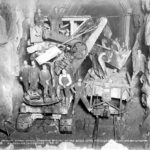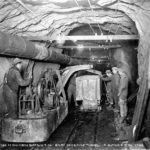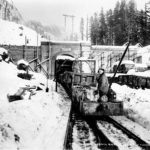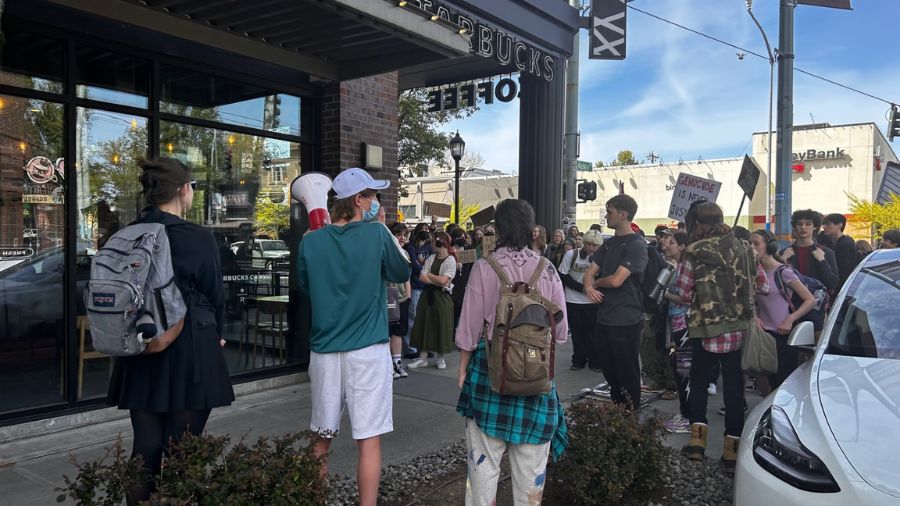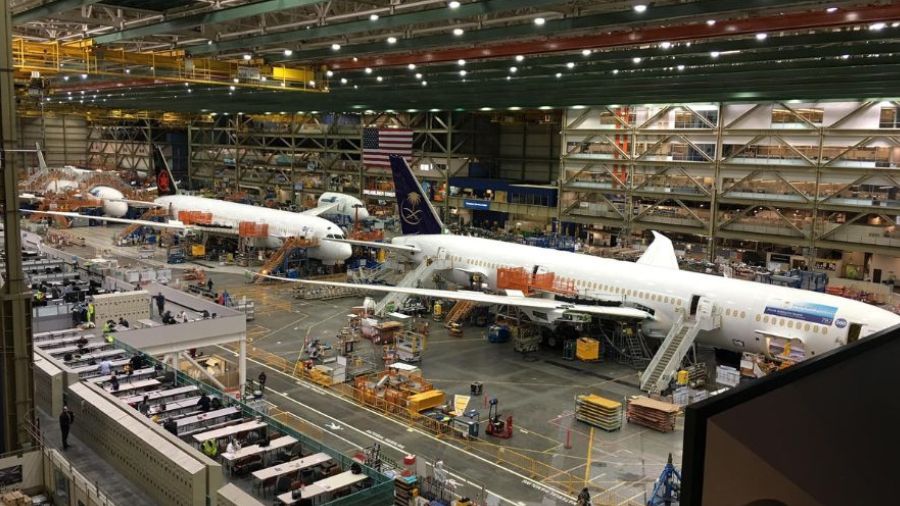Cascade Tunnel still going strong in 90th year
Jan 17, 2018, 6:20 AM | Updated: Oct 4, 2022, 2:22 pm
“The Great Cascades have been materially moved by the ingenuity of man . . . Just a matter of a few weeks more than three years ago, ground was broken for this amazing hole in the ground, a hole eight miles long, boring straight as a gun barrel through the backbone of the Cascades, a backbone of fearfully [blast resistant] granite. From this hole was taken 800,000 cubic yards of rock and muck, 260,000 cubic yards of concrete now serves as its lining, and 40,000 cubic yards of gravel and crushed rock is now the track ballast.”
These were the words 89 years ago this month of NBC announcer Graham McNamee, standing not far from where Highway 2 now winds up the east side of Stevens Pass at the community of Berne, as the Great Northern Railway prepared to dedicate the Cascade Tunnel.
It was really two special occasions in one: the dedication of the eight-mile-long tunnel that remains in use to this day, as well as a boldly ambitious live broadcast linking Stevens Pass with New York, San Francisco and Washington, DC, and with countless radio listeners around the United States. Vintage audio of the complete program that, remarkably, still exists, is thought to be the oldest surviving recording of a radio broadcast originating in Washington state.
After potential transcontinental routes were surveyed by the government in the 1850s, railroads from the east began to reach the Pacific Northwest beginning in the 1880s. Proximity to cross-country tracks meant economic vitality – life or death for some communities – and competition was fierce, with Seattle and Tacoma fighting for years to lure the Northern Pacific terminus, and local investors launching their own homegrown efforts to build a railroad and make it run.
Lake Washington shipyard created Eastside’s first traffic
Scott Tanner is an amateur historian and collector and serves on the board of directors of the not-for-profit Great Northern Railway Historical Society. He says the Cascade Tunnel was a significant investment and an important step forward for the Great Northern, which, unlike other railroads, was built without government subsidies.
“The opening of the Cascade Tunnel in 1929 eliminated over seven miles of snow sheds and about three and a half miles of other tunnels” as well as about 500 feet of elevation, Tanner said. He says the overall improvement project over Stevens Pass also included straightening miles of track and eliminating switchbacks on the railway’s original route through the Cascades, which dated to the 1890s and which included the site of the deadly 1910 Wellington Disaster.
Tanner also says that once they decided to go ahead with the project, the railroad didn’t waste any time.
“[The] Great Northern Railway board of directors approved this [project] on Thanksgiving Day 1925, and it was only a couple days later they had their contractor, A. Guthrie and Company, lined up to get started,” Tanner said. “And it just took a little over three years to complete the job, and it was off by only a few inches, vertically and horizontally. It was incredibly precise.”
The total project budget was $25 million, or about $350 million today, adjusted for inflation.
Whatever the cost, building the Cascade Tunnel, according to Scott Tanner, was part of a natural progression for the Great Northern Railway, even though its founder, James J. Hill, who was known as the “Empire Builder,” had passed away in 1916.
“One of the key pieces of railroad building or railroad operation philosophies of James J. Hill was to have a railroad that had the least curvature, that had the lowest elevations,” Tanner said. “And so it was really important for him to find the lowest passes over the mountains that they had to conquer.”
Conquering Stevens Pass
Hill’s ace-in-the-hole when it came to engineering the route of the Great Northern from its Twin Cities headquarters to the Pacific Coast was the legendary John F. Stevens, the man for whom Stevens Pass is named.
“John F. Stevens was a remarkable railroad man,” Tanner said. “He was involved in the Panama Canal and the Trans Siberian Railway in Russia, but he was the Chief Engineer of the Great Northern Railway for many years.”
A bronze statue of Stevens, dedicated in 1925 – somewhat unusually while he was still alive – is visible from the old Great Northern tracks where they cross the Continental Divide at Marias Pass in the Montana Rockies – one of the routes that Stevens engineered for the Great Northern.
Stevens was on hand for the Cascade Tunnel dedication back in 1929 in the pass that bears his name, though he didn’t speak on that occasion. Those duties fell mostly to NBC’s Graham McNamee, emcee for the national broadcast. Producing such a broadcast had only recently become possible; NBC had just weeks earlier complete construction of a nationwide network of wires and amplifiers to connect 36 network-affiliated radio stations around the United States.
Though not remembered much today, McNamee was a gifted and experienced broadcaster in the earliest years of radio in 1920s and throughout much of the 1930s. His skills are clear during the Cascade Tunnel broadcast, as he competes with a loud whistle while describing the special train that would inaugurate service through the tunnel, as it approached from the east and rolled slowly toward what was called the East Portal.
“Ladies and Gentleman, the Oriental Limited of the Great Northern will be with us in a very few moments and we will be ready to start on this great trip, the first train to go through the Cascade Tunnel,” McNamee told the audience. “This train tonight carries 25 coaches. I think that is somewhat [WHISTLE] . . . there’s the train! Did you hear the whistle? There it is. And that is the Oriental Limited.”
McNamee then climbed aboard the Oriental Limited for an eight-mile ride through the new tunnel. He was to emerge a short while later at the community of Scenic, site of a boomtown of 1,800 that popped up during construction of the tunnel. There, McNamee would resume broadcasting, and, ultimately, introduce President-Elect Herbert Hoover, who would speak live from Washington, DC.
But something went wrong.
Stalling for time
According to her 1995 book Stevens Pass: Gateway to Seattle, author Joann Roe writes that the electric locomotive pulling the Oriental Limited stalled just inside the East Portal due to differences in indoor/outdoor temperature and humidity that created condensation. An additional locomotive was brought in to push the train through the tunnel, but it was slow-going.
By some accounts, it took anywhere from 27 minutes to 35 minutes for the Oriental Limited to make it the eight miles from the East Portal to the West Portal. While the radio audience waited and announcer Philips Carlin managed the broadcast and stalled from New York, the time was filled with music. And music. And more music.
Once it finally arrived at the west end of the Cascade Tunnel, the lead locomotive dramatically burst through a huge piece of paper decorated to look like a wall of rock.
For Graham McNamee, it must have all been pretty anticlimactic. When he got back on the NBC microphone from Scenic at the West Portal, he sounded a little flustered. And also somewhat underwhelmed.
“Ladies and gentleman, we are now at the West Portal of the Cascade Tunnel. We got onto the train, jumped through a few cars and got out onto the pilot of the engine,” McNamee told the NBC audience.
“It certainly was a lovely sight coming through that tunnel. We expected to find a great deal of excitement and so forth among the guests in the 25 cars, but there was nothing of the sort. It was just a quiet little ride through a very nice tunnel,” he continued.
“The passengers’ reaction was a complete disappointment,” McNamee reported. “They didn’t react at all. They just sat there as though they were out having lunch someplace.”
Within a few minutes, President-Elect Hoover spoke to end the broadcast. And rather than having lunch someplace, the guests aboard the train disembarked and joined other dignitaries for a slightly delayed banquet at Scenic.
Scott Tanner says that in spite of those inaugural passengers and their poker-faced reactions to the ride, the Cascade Tunnel is considered a successful project. It’s still there and being used by trains every day, even if the once-famous “Great Northern Railway” name and Rocky the mountain goat mascot disappeared decades ago.
“There were several major railroads serving the Pacific Northwest that were together thought of as the ‘Hill Lines,’” Tanner said. “James J. Hill was referred to as the ‘Empire Builder,’ and for good reason.”
Why would Seattle remove a perfectly good shortcut?
Ultimately, Tanner says, Hill controlled the Great Northern and the rival Northern Pacific, and he also owned interests in the Chicago, Burlington and Quincy Railroad and the Spokane, Portland and Seattle Railway.
“Over the years, there were efforts to try and merge those four into one railroad, and this happened several times in the 1920s, and again in the 1950s and early 1960s,” Tanner said. “Finally, the [Interstate Commerce Commission] approved of the merger, and it took place in March of 1970 and formed Burlington Northern Railroad, which later merged with Santa Fe and it’s become today’s BNSF.”
Remnants of the Great Northern Railway
Scott Tanner says that he used to think that more than just the name of the Great Northern Railway had disappeared.
“Years ago, at one of our annual conventions for the Great Northern Railway Historical Society, I got to chatting with a fellow who was one of the vice presidents of the Great Northern Railway, and [who] was instrumental in the merger that created Burlington Northern,” Tanner said. “And I was bemoaning the fact that on these conventions . . . when they tried to put together a tour, about the best they could do was take us on a bus out in the middle of some vacant field somewhere with some pieces of concrete and say, ‘There’s what’s left of the foundation of a building that used to be used for the Great Northern Railway.’”
Tanner says this lament got the old railroad exec’s attention.
“’He said, ‘Hang on a minute,’” Tanner said. Then, the man told him, “The Great Northern Railway didn’t disappear. It’s still there. It’s still there everywhere you look. It’s there in the routes, in the low elevation lines, in the efficient operation and movement of freight,” And, the man continued, “You just have to know what to look for. It’s not just remnants of foundations of buildings that no longer exist.”
That long-ago interaction changed Scott Tanner’s view of the old railroad and given him an even deeper appreciation of the tangible legacy James J. Hill.
“There are a lot of things like Cascade Tunnel that have stood the test of time,” Tanner said. “There’s what they call Bridge Four, the Salmon Bay Bridge built by the Great Northern Railway [and] opened in about 1904. And there’s other bridges, like the one across the Wenatchee River at Rock Island . . . it’s been there since the 1890s, and been in daily use ever since.”
IF YOU GO: The East Portal of the Cascade Tunnel is visible from Highway 2, and if you’re willing to park your car and take a walk, much of the old pre-Cascade Tunnel route of the Great Northern Railway is accessible via the Iron Goat Trail.






